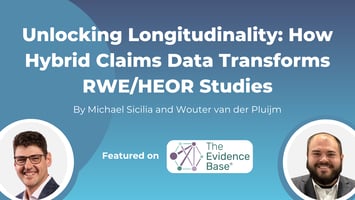Healthcare organizations are increasingly recognizing that patient outcomes extend far beyond...
Driving Healthcare Innovation Through Hybrid Data
As healthcare advances and transforms, data is the key to driving innovation, efficiency, and improved patient outcomes. Traditionally, real-world data (RWD), consisting of open and closed claims and electronic health records (EHR), have existed in silos, each offering valuable but partial insights into patient care, treatment effectiveness, and population health trends. By seamlessly integrating these datasets into a hybrid ecosystem, life sciences, pharmaceutical, medical device, and healthcare technology companies can unlock a wealth of opportunities to enhance analytics, reduce costs, and make more informed patient care decisions.
The Need for Hybrid Data Access
For decades, the industry has relied on open and closed claims data for its structured, longitudinal view of patient encounters. However, while claims data offers comprehensive diagnosis, treatment, and procedure records, it lacks the clinical depth necessary for nuanced decision-making. Conversely, EHR data provides rich clinical details, including semi-structured notes, lab results, and vital signs, but is often fragmented and difficult to aggregate at scale. A hybrid claims-EHR ecosystem solves this challenge by linking these disparate datasets at the patient level for a more complete treatment view. Integrating both open and closed claims in the claims-EHR ecosystem and creating a singular, standardized schema ensures interoperability and ease of use.
Key advantages of a hybrid data ecosystem include:
- Cost and Procurement Time Savings: Organizations can avoid the high costs and lengthy timelines associated with acquiring, cleaning, and harmonizing multiple datasets from various sources.
- Streamlined Analytics: A standardized data schema simplifies analysis, reducing the burden of data wrangling and accelerating insights.
- Comprehensive Patient-Centric Analysis: By linking open and closed claims and EHR data, organizations can track the same patient across multiple settings, unlocking new insights previously siloed due to fragmented data sources.
Hybrid Data Advantages

Maximizing Efficiency and Insights with Hybrid Data
In 2025, life sciences companies are under increasing pressure to save time and reduce costs while continuing to operate at the same levels of production, as capital becomes more expensive and resources remain limited. Hybrid ecosystems help address both challenges by streamlining workflows and improving efficiency.
Setting up infrastructure, managing contracts, integrating data sources, achieving statistical certification, applying HIPAA redactions, and standardizing data into a common model require significant time, expertise, and financial investment. Organizations can alleviate these burdens by utilizing these data ecosystems, which streamline complex processes and reduce resource demands. In engagements with pharmaceutical companies, Forian has seen upwards of 57% company cost savings and 72% time savings when utilizing a ready-to-use hybrid data ecosystem versus a bootstrapped approach.
The Patient Journey

The above patient journey graphic highlights how integrating open and closed medical and pharmacy claims provides a more complete view of patient care. The timeline spans office visits, hospitalizations, prescriptions, and procedures, even as the patient transitions between health plans. Leveraging both data sources as one package allows healthcare organizations to save on resources while also gaining deeper insights into treatment patterns and patient outcomes. Layering EHR into the patient above allowed for longitudinal measuring of potassium and lipid levels and the results of the complete blood count lab test.
Addressing Data Interoperability and Privacy Concerns
One of the biggest challenges in leveraging healthcare data is ensuring interoperability. Linked hybrid data solves this by aligning all datasets to a common structure, eliminating inconsistencies, and making the data fit-for-purpose for a wide range of applications.
Privacy and compliance considerations are paramount when working with patient-level data. Regulations such as HIPAA and similar global frameworks impose strict requirements for data security, de-identification, and statistical validation. By leveraging a hybrid dataset that has already undergone rigorous regulatory certifications and linkage, organizations can confidently deploy analytics solutions without additional compliance burdens.
Impact on Patient Outcomes
Beyond operational efficiencies, a hybrid data approach has profound implications for patient care. By integrating claims and EHR data, organizations can develop more personalized treatment strategies, improve adherence monitoring, and enhance real-world evidence generation.
This comprehensive data linkage allows for earlier detection of things like disease progression and identification of high-risk patients who may benefit from proactive interventions. Analyzing both claims and clinical data allows providers to recognize patterns in medication adherence and flag patients who may be at risk for complications due to things like missed prescriptions or inconsistent follow-up care. This enables healthcare teams to implement timely outreach programs, reducing hospitalizations and improving long-term outcomes.
Additionally, hybrid data can support more equitable healthcare by identifying disparities across different populations. Access to more complete patient histories allows providers and researchers to identify gaps in care, make better clinical decision-making, reduce healthcare costs, and ultimately improve patient outcomes.
Conclusion
The ability to seamlessly access and analyze hybrid open and closed claims and EHR data is transforming the life sciences and healthcare technology industries. Organizations that leverage this integrated approach will be better positioned to innovate, optimize their analytics strategies, and drive meaningful improvements in patient care. As the industry continues to evolve, having access to high-quality, linked data will be a key differentiator for companies aiming to stay ahead in an increasingly data-driven world.




.png?height=200&name=Blog%20Cover%20Image%20Hybrid%20Claims%20Data%20The%20Essential%20Strategy%20for%20Enhanced%20RWE%20and%20HEOR%20Studies%20(2).png)
